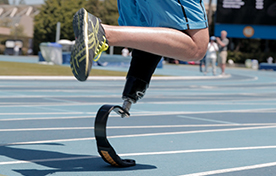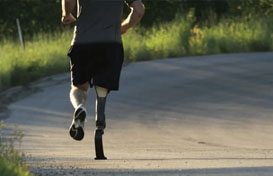Prosthetic Socks: Simple, Relatively Inexpensive and Critically Important
– by M. Jason Highsmith, DPT, CP(c) and Jason T. Kahle, CPO
Is there really that much to know about socks?

Socks are a simple enough invention. In most instances, socks serve as a barrier between the foot and a shoe. For the nonamputee, the inside of a shoe is essentially an interface, much as the inside of a prosthesis is the interface for the residual limb of an amputee. An interface is the place where the human body directly interacts with a device to indirectly contact the outside environment. Because the interface is generally a rather fixed environment (in terms of shape and/or volume), some form of barrier is generally needed. In the case of a foot and shoe, a sock may serve to wick away perspiration and odor and generally increase the comfort of the foot. This is similar to a sock’s function within a prosthesis. In both cases, the sock serves as a readily removable and washable part of the interface that prevents direct contact with the shoe or prosthesis. In this role, the oils, odors and contaminants produced by the residual limb may be removed and eliminated before reusing the sock.
As most experienced amputees know, socks serve to occupy space where tissue and fluid volume have decreased. In this case (volume loss), using a prosthesis without a sock (or socks) will likely cause the residual limb to sink farther into the prosthesis. This causes excess weight bearing or pressure in places that are not intended for such loading. In a transtibial (below-knee) residual limb, the distal end (or bottom) may be the problem area or it may be higher on the leg, near the knee joint. If the pain is near the knee joint, the problem may be that the bones at the knee joint are contacting prior to contact at the bottom of the limb (Figure 1). Pain in either place could be the result of volume loss (shrinking) and may indicate the need for a sock. In the case of a transfemoral (aboveknee) residual limb where a silicone suspension or socks and a Silesian belt are used, volume loss could also create a problem at the bottom of the residual limb as the limb sinks farther into the interface, or socket (Figure 2). If, however, the bones of the pelvis contact the socket prior to the bottom, then pain around the groin could result.

At this point, you may be thinking that you’ve heard this a hundred times from your prosthetist or therapist, but there is actually more – much more. You may be one of those people who insist on wearing a sock under your gel liner. Well, sock manufacturers have learned from you and devised socks that are intended for exactly this purpose. These special socks are thinner to increase suspension relative to “standard” prosthetic socks and contain silver fibers, which reportedly protect against odor and bacteria. So be sure to talk to your provider to get socks made for use under a liner rather than using a “standard” sock, as the function and composition are quite different.
Some socks may require a special cut for proper use. Two examples are quite common. The first is cutting the toe section off of a sock when using a suction liner. The seal on the outside of the liner is located toward the bottom of the liner, and it must maintain secure contact with the inner surface of the socket or suction will be lost. People wearing this system, like all others, are still subject to daily volume change and will still likely need to wear prosthetic socks at some point. Hence, removal of the sock’s toe section permits suction while wearing socks.

The second example of specially cutting a prosthetic sock is present when a “half” sock is needed. This situation arises most commonly with transtibial residual limbs. In this case, comfort was likely satisfactory for some time as your residual limb slowly lost volume. You likely added socks for relief until you reached the point when adding another ply of sock increased pressure, causing discomfort around the bones of the knee joint. Distally, near the bottom, the socket was still loose. In such a case, the area below the bones of the knee, primarily composed of muscle with higher fluid content than the bony part of the knee joint, has likely undergone muscular atrophy and fluid loss. Atrophy and fluid loss create a total reduction in volume at the bottom of the limb. The solution here is to add socks only distally, where the change is most prominent. A full-length prosthetic sock is cut at about the level of the fibula head, or slightly below (Figure 3). This new “half” sock is donned as the first sock with other, full-length socks donned over it to prevent the half sock from rolling down and/or bunching. This increases volume lost at the bottom of the limb while decreasing the excess pressure created at the top of the knee joint from using only fulllength socks.
Special applications exist for people wearing transfemoral prostheses as well. Some have requested that their prosthesis be fit with a certain ply of prosthetic sock so that they could fold the sock over the top of the socket, where the interface contacts the sensitive pelvic region. A more intimate fit would not initially permit the use of a sock and thus the sock could not be folded over the brim (top edge) of the socket. These people have reported that the sock “gasket” (as it has been referred to) aids in padding the socket brim against soft groin tissues and helps with perspiration.
What about sock maintenance? Yes, this is an issue. Aside from obvious hygienic concerns, usually remedied with washing and drying as indicated, other needs may exist. For example, the edges of socks are notorious for fraying. In many cases this is little more than a nuisance, as lint will accumulate in various places or get loose on floors or garments. At times, this lint can accumulate within a pin lock mechanism or suction valve and impair suspension. If the frayed edge of a sock surrounding its pin hole is not trimmed, the loosely attached strands could enter the lock mechanism with the pin and become jammed, making it extremely difficult to remove the prosthesis.
There are numerous other clinical techniques, procedures and applications that involve the use of prosthetic socks. We estimate that approximately 70 to 85 percent of prosthetic office visits involve sock wear modification or application. Diagnostically, you can estimate and track daily volume change and attempt prosthetic sock ply change yourself as a home remedy to relieve prosthetic discomfort. Even if this doesn’t work, the outcome information of your attempts can help the practitioner in narrowing down the source of your problems.
Socks obviously come in a tremendous variety of sizes so that virtually any diameter or length limb may be accommodated. Additionally, custom orders for “nontraditional” shapes may be available via special order. Some people prefer nylon, cotton or wool, while others prefer socks of synthetic material blends. The available materials and brands alone are staggering even within the confines of what may be clinically indicated in a particular situation. Your prosthetist probably has extensive experience with many available sock products. Prosthetists usually have their preferences for several reasons, as do you. If you’ve seen or heard about a new product or technique, talk to your prosthetist about the potential benefits and drawbacks in your case. In some instances, a vendor may be willing to send a sample for you to try. If you have had a less than ideal experience with a particular sock product, don’t give up on the idea of wearing them because the results could be catastrophic to your residual limb.
About the Authors
Jason T. Kahle is a certified and licensed prosthetist/orthotist. He is the director of lower-extremity prosthetics at Westcoast Brace & Limb in Tampa, Florida.
M. Jason Highsmith is a physical therapist and board-eligible prosthetist. He is an assistant professor in the School of Physical Therapy at the University of South Florida.
Disclaimer: The following information is provided and owned by the Amputation Coalition of America and was previously published on the website http://www.amputee-coalition.org or the Coalitions Newsletter, inMotion.








